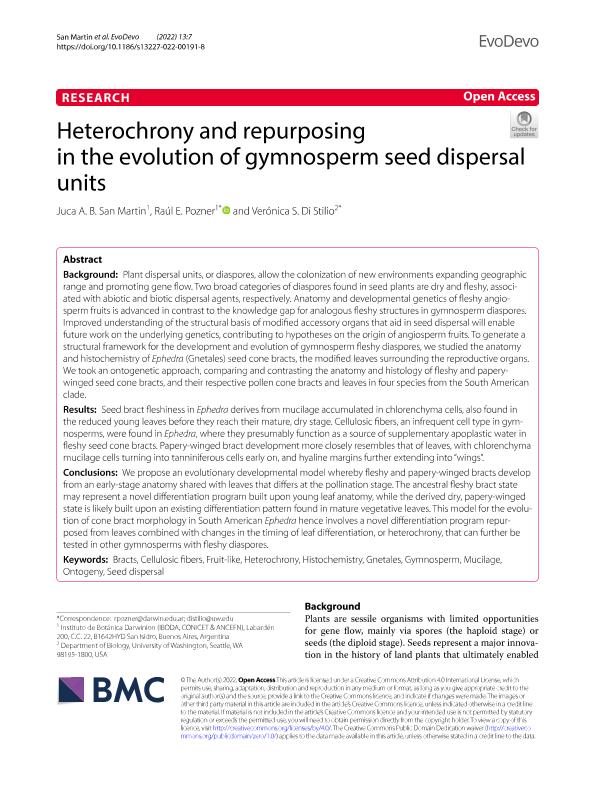Mostrar el registro sencillo del ítem
dc.contributor.author
Abramo Barrera San Martin, Juca

dc.contributor.author
Pozner, Raúl Ernesto

dc.contributor.author
Di Stilio, Verónica Sandra

dc.date.available
2023-08-31T12:04:28Z
dc.date.issued
2022-02
dc.identifier.citation
Abramo Barrera San Martin, Juca; Pozner, Raúl Ernesto; Di Stilio, Verónica Sandra; Heterochrony and repurposing in the evolution of gymnosperm seed dispersal units; BioMed Central; EvoDevo; 13; 1; 2-2022; 2-19
dc.identifier.issn
2041-9139
dc.identifier.uri
http://hdl.handle.net/11336/210024
dc.description.abstract
Background: Plant dispersal units, or diaspores, allow the colonization of new environments expanding geographic range and promoting gene flow. Two broad categories of diaspores found in seed plants are dry and fleshy, associated with abiotic and biotic dispersal agents, respectively. Anatomy and developmental genetics of fleshy angiosperm fruits is advanced in contrast to the knowledge gap for analogous fleshy structures in gymnosperm diaspores. Improved understanding of the structural basis of modified accessory organs that aid in seed dispersal will enable future work on the underlying genetics, contributing to hypotheses on the origin of angiosperm fruits. To generate a structural framework for the development and evolution of gymnosperm fleshy diaspores, we studied the anatomy and histochemistry of Ephedra (Gnetales) seed cone bracts, the modified leaves surrounding the reproductive organs. We took an ontogenetic approach, comparing and contrasting the anatomy and histology of fleshy and papery-winged seed cone bracts, and their respective pollen cone bracts and leaves in four species from the South American clade. Results: Seed bract fleshiness in Ephedra derives from mucilage accumulated in chlorenchyma cells, also found in the reduced young leaves before they reach their mature, dry stage. Cellulosic fibers, an infrequent cell type in gymnosperms, were found in Ephedra, where they presumably function as a source of supplementary apoplastic water in fleshy seed cone bracts. Papery-winged bract development more closely resembles that of leaves, with chlorenchyma mucilage cells turning into tanniniferous cells early on, and hyaline margins further extending into “wings”. Conclusions: We propose an evolutionary developmental model whereby fleshy and papery-winged bracts develop from an early-stage anatomy shared with leaves that differs at the pollination stage. The ancestral fleshy bract state may represent a novel differentiation program built upon young leaf anatomy, while the derived dry, papery-winged state is likely built upon an existing differentiation pattern found in mature vegetative leaves. This model for the evolution of cone bract morphology in South American Ephedra hence involves a novel differentiation program repurposed from leaves combined with changes in the timing of leaf differentiation, or heterochrony, that can further be tested in other gymnosperms with fleshy diaspores.
dc.format
application/pdf
dc.language.iso
eng
dc.publisher
BioMed Central

dc.rights
info:eu-repo/semantics/openAccess
dc.rights.uri
https://creativecommons.org/licenses/by/2.5/ar/
dc.subject
BRACTS
dc.subject
CELLULOSIC FIBERS
dc.subject
FRUIT-LIKE
dc.subject
GNETALES
dc.subject
GYMNOSPERM
dc.subject
HETEROCHRONY
dc.subject
HISTOCHEMISTRY
dc.subject
MUCILAGE
dc.subject
ONTOGENY
dc.subject
SEED DISPERSAL
dc.subject.classification
Ciencias de las Plantas, Botánica

dc.subject.classification
Ciencias Biológicas

dc.subject.classification
CIENCIAS NATURALES Y EXACTAS

dc.subject.classification
Biología del Desarrollo

dc.subject.classification
Ciencias Biológicas

dc.subject.classification
CIENCIAS NATURALES Y EXACTAS

dc.title
Heterochrony and repurposing in the evolution of gymnosperm seed dispersal units
dc.type
info:eu-repo/semantics/article
dc.type
info:ar-repo/semantics/artículo
dc.type
info:eu-repo/semantics/publishedVersion
dc.date.updated
2023-08-08T13:46:52Z
dc.journal.volume
13
dc.journal.number
1
dc.journal.pagination
2-19
dc.journal.pais
Estados Unidos

dc.description.fil
Fil: Abramo Barrera San Martin, Juca. Consejo Nacional de Investigaciones Científicas y Técnicas. Instituto de Botánica Darwinion. Academia Nacional de Ciencias Exactas, Físicas y Naturales. Instituto de Botánica Darwinion; Argentina
dc.description.fil
Fil: Pozner, Raúl Ernesto. Consejo Nacional de Investigaciones Científicas y Técnicas. Instituto de Botánica Darwinion. Academia Nacional de Ciencias Exactas, Físicas y Naturales. Instituto de Botánica Darwinion; Argentina
dc.description.fil
Fil: Di Stilio, Verónica Sandra. University of Washington; Estados Unidos
dc.journal.title
EvoDevo
dc.relation.alternativeid
info:eu-repo/semantics/altIdentifier/url/https://evodevojournal.biomedcentral.com/articles/10.1186/s13227-022-00191-8
dc.relation.alternativeid
info:eu-repo/semantics/altIdentifier/doi/http://dx.doi.org/10.1186/s13227-022-00191-8
Archivos asociados
